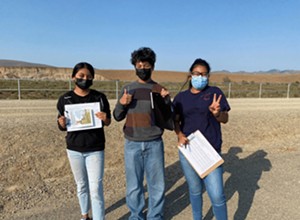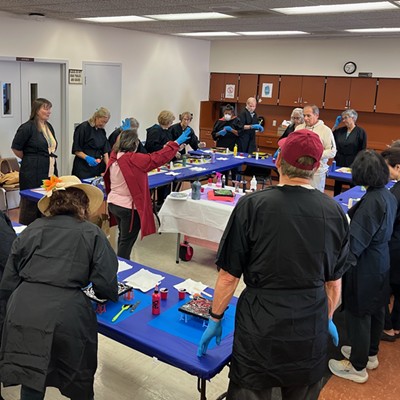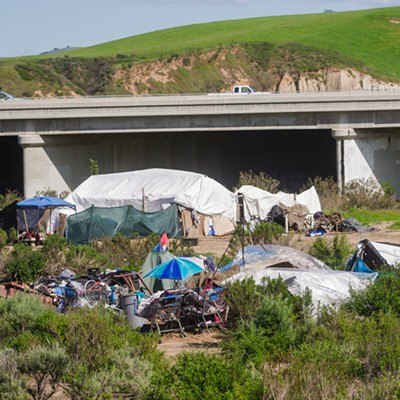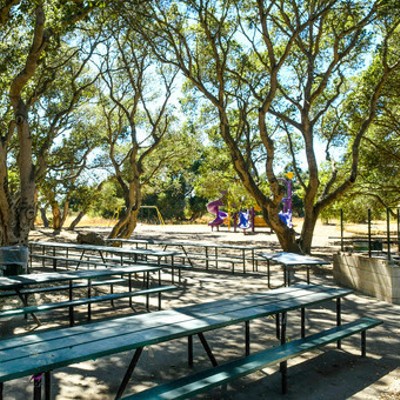Dirt squishes beneath tightly laced hiking boots, and the trees shadow the sun as the trail begins to incline. A fresh breeze blows through the grass and ahead is nothing but the rolling hills of Santa Barbara County. Trails are nearby—maybe within walking distance from some homes—where residents and visitors can embrace the true beauty of the Central Coast.
At least, that’s the case in southern Santa Barbara County.
Not that there aren’t open spaces and trails available in North County, but there aren’t enough with easy access, said Central Coast Alliance United for a Stable Economy (CAUSE) Policy Advocate Rebeca Garcia.
“The issue came up because the youth are wanting more places to move around safely outside. It expanded more and more when we realized how intersectional it is because at its core it’s a place for people to [safely] walk, bike, and run, but it’s also an environmental justice issue,” Garcia explained.

Policy advocates and high schoolers involved in the CAUSE Youth program spoke during the May 17 Board of Supervisors meeting to advocate for the Santa Maria River Levee Trail expansion.
When looking at Santa Barbara city and Santa Maria, CAUSE advocates noted in a statement that while Santa Barbara has more than 130 miles of trails across 52 options, Santa Maria has a mere 8 miles of trails across two options in the city.
“When we look at access across the nation, communities of color are three times more likely to be green-space deprived,” Garcia added.
According to a study conducted by the Center for American Progress, 74 percent of communities of color in the United States live in nature-deprived areas, compared with just 23 percent of white communities.
“Notably, families with children—especially families of color with children—have less access to nature nearby than the rest of the country. In other words, these communities are nature deprived,” the study stated. “These disparities are particularly concerning because nature is not an amenity but a necessity for everyone’s health and well-being.”
To combat these disparities, community organizations and local governments are creating new avenues through carpool programs, park development, and advocacy platforms to get people better outdoor access.
But barriers tend to extend deeper than people realize, said Jeff Kuyper, the executive director of Los Padres ForestWatch, an advocacy group dedicated to preserving the Los Padres National Forest.
“I think historically the outdoor recreation community’s been influenced by wealthy white people,” Kuyper said. “It’s everything from where trails are located and maintained to what clothing models and outdoor clothing catalogs look like, but the recognition is there that there’s this huge community of people of color who have been ignored for so long.”
Such disparity can even be seen in Los Padres National Forest, he continued. Although it’s a huge piece of land that’s supposed to be open to everybody, access to trails and trail maintenance in the northern parts of Santa Barbara County remain difficult.
“Once you enter the forest [in North County] there’s no signs saying ‘entering Los Padres Forest,’ as you would see on a lot of the other highways. Right away, there’s this lack of recognition,” Kuyper said.
Resource devotion also varies between the forest’s corridors, with South County areas receiving more funds and resources for trail maintenance, signage, and kiosks, whereas the North County counterparts get the short end of the stick—with a lack of signage, trail maps, and parking, Kuyper explained.
“The reason for that is unknown, but generally if you look at where the bulk of the Forest Service funding goes, it’s not in that [North County] corridor, it’s areas in South County that seem to get more attention, and that should change,” he said. “There’s so many amazing places to explore and enjoy in North County, and it’s unfortunate that substantial resources are not devoted to highlighting those and making them accessible to everyone.”
Accessibility difficulties add to many existing barriers community members face, like transportation costs, a lack of knowledge, and a general sense of feeling unwelcome when trying outdoor activities for the first time, Kuyper said.
The Forest Service takes a biannual visitors survey and found that those who are Hispanic or Latino make up about 20 percent of the visitation—not nearly equivalent to the county’s makeup (85 percent Latino), he said. According to 2020 U.S. Forest Service data, people who identified as Hispanic or Latino made up only 7 percent of visitation across the country.
“The numbers speak for themselves, and it’s part of this whole dynamic we see of resources and attention not placed on trails that are closest to those areas,” Kuyper said.
North County also tends to have more agricultural land and larger parcels of private property, making it more challenging to get trails developed, said Gabriela Cabrillo—Los Padres ForestWatch director of youth and community engagement. To promote outdoor access, Cabrillo and her team advocate for bills to promote outdoor access and lead trips for families to experience the outdoors for the first time.
“This is about showing them where to go, and letting them know these are public spaces and everyone’s welcome,” Cabrillo said. “But it becomes a socioeconomic issue when many trailheads are at least 45 minutes away and the price of gas is too much.”
One need the county should fill is to provide an equity coalition: a group dedicated to finding outdoor access barriers and creating solutions to mitigate them, Cabrillo said.
“The Central Coast has always been very focused on environment and recreation causes, but the social justice component just has been overlooked,” she added.
State and local governments are working to get more green space access to their communities. California passed the Outdoor Equity Grants program—coauthored by State Sen. Monique Limón (D-Santa Barbara)—to provide funding for outdoor recreation and environmental opportunities for under-resourced communities. Gov. Gavin Newsom drafted a nature conservation plan—called “30x30”—which includes a component to advance equitable access.
At a city level, Santa Maria Parks and Recreation received a $589,000 grant from California State Parks to provide community members transportation to different nearby natural areas and provide outdoor education programs.
The county’s parks department is building its recreation master plan—a guide to new park and trail development, said Aquatics and Trails Coordinator Jon Menzies.
Menzies recommended that residents advocate for their needs through completing a survey or during community meetings to get funds and resources for the expansion of much needed trails and their maintenance. He said he’s noticed in the past that North County property owners tend to fight against development in order to preserve their properties.
“If we are trying to spend a whole lot of money, we have to know there’s a demand. We can’t just make it up as we go along,” Menzies said. “The timing is now if we want to get anything done in the future.
“A lot of times people don’t participate until it’s decades late. It’s time to plan ahead.”
Staff Writer Taylor O’Connor can be reached at [email protected].










